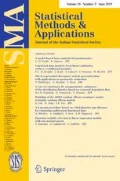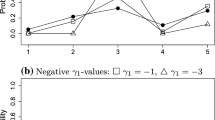Abstract
Conventional, parametric multinomial logit models are in general not sufficient for capturing the complex structures of electorates. In this paper, we use a semiparametric multinomial logit model to give an analysis of party preferences along individuals’ characteristics using a sample of the German electorate in 2006. Germany is a particularly strong case for more flexible nonparametric approaches in this context, since due to the reunification and the preceding different political histories the composition of the electorate is very complex and nuanced. Our analysis reveals strong interactions of the covariates age and income, and highly nonlinear shapes of the factor impacts for each party’s likelihood to be supported. Notably, we develop and provide a smoothed likelihood estimator for semiparametric multinomial logit models, which can be applied also in other application fields, such as, e.g., marketing.

Similar content being viewed by others
References
Abe M (1998) Measuring consumers nonlinear brand choice response to price. J Retail 74:541–568
Abe M (1999) A generalized additive model for discrete-choice data. J Bus Econ Stat 17:271–284
Adler D, Murdoch D (2009) Package ‘rgl’—3D visualization device system (OpenGL). http://rgl.neoscientists.org
Akima H (1978) A method of bivariate interpolation and smooth surface fitting for irregularly distributed data points. ACM Trans Math Softw 4:148–164
Ben-Akiva M, Lerman SL (1985) Discrete choice analysis: theory and application to travel demand. The MIT Press, Cambridge, MA
Curtice J, Firth D (2008) Exit polling in a cold climate: the BBCITV experience in Britain in 2005. J R Stat Soc Series A 171:509–539
Domencich T, McFadden D (1975) Urban travel demand: a behavioral analysis. North-Holland publishing Co., Amsterdam
Dow JK, Endersby JW (2004) Multinomial probit and multinomial logit: a comparison of choice models for voting research. Elect Stud 23:107–122
Fisher SD, Ford R, Jennings W, Pickup M, Wlezien C (2011) From polls to votes to seats: forecasting the, 2010 British general election. Elect Stud 30:250–257
Gneiting T, Raftery AE (2007) Strictly proper scoring rules, prediction, and estimation. J Am Stat Assoc 102:359–378
Härdle W, Huet S, Mammen E, Sperlich S (2004a) Bootstrap inference in semiparametric generalized additive models. Econ Theory 20:265–300
Härdle W, Müller M, Sperlich S, Werwatz A (2004b) Nonparametric and semiparametric models. Springer Series in Statistics, Berlin
Hastie TJ, Tibshirani RJ (1986) Generalized additive models. Stat Sci 1:297–318
Hausman J, McFadden D (1984) Specification tests for the multinomial logit model. Econometrica 52:1219–1240
Kalyanaram D, Little JDC (1994) An empirical analysis of latitude of price acceptance in consumer package goods. J Consumer Res 21:408–418
Kneib T, Baumgartner B, Steiner WJ (2007) Semiparametric multinomial logit models for analysing consumer choice behaviour. Adv Stat Anal 91:225–244
Köhler M, Schindler A, Sperlich S (2014) A review and comparison of bandwidth selection methods for Kernel regression. Int Stat Rev (in press)
Krishnamurthi L, Raj SP (1988) A model of brand choice and purchase quantity price sensitivities. Market Sci 7:1–20
Lösche P (1993) Kleine Geschichte der deutschen Parteien. Kohlhammer, Stuttgart
McFadden D (1974) Conditional logit analysis of qualitative choice behavior. In: Zarembka P (ed) Frontiers in econometrics, Academic Press, New York, pp 105–142
Müller M (2001) Estimation and testing in gerneralized partial linear models: a comparative study. Stat Comput 11:299–309
Quinn KM, Martin AD, Whitford AB (1999) Voter choice in multi-party democracies: a test of competing theories and models. Am J Political Sci 43:1231–1247
Roca-Pardinas J, Sperlich S (2010) Feasible estimation in generalized structured models. Stat Comput 20:367–379
Severini TA, Wong WH (1992) Generalized profile likelihood and conditionally parametric models. Ann Stat 20:1768–1802
Small KA, Hsiao C (1985) Multinomial logit specification tests. Int Econ Rev 26:619–627
Sperlich S, Tjøstheim D, Yang L (2002) Nonparametric estimation and testing of interaction in additive models. Econ Theory 18:197–251
Tutz G, Scholz T (2004) Semiparametric modelling of multicategorical data. J Stat Comput Simul 74:183–200
Walter F (2008) Baustelle Deutschland. Suhrkamp, Frankfurt am Main
Yee TW, Wild CJ (1996) Vector generalized additive models. J R Stat Soc B 58:481–493
Acknowledgments
The authors would like to thank Walter Zucchini and two anonymous referees for helpful comments on earlier versions of this paper. Furthermore, the authors are very grateful to Thomas Kneib for helping us with the use of the BayesX software to realize the comparison with his method. The third author acknowledges financial support from the Swiss National Science Foundation, project 100018-140295.
Author information
Authors and Affiliations
Corresponding author
Electronic supplementary material
Below is the link to the electronic supplementary material.
Rights and permissions
About this article
Cite this article
Langrock, R., Heidenreich, NB. & Sperlich, S. Kernel-based semiparametric multinomial logit modelling of political party preferences. Stat Methods Appl 23, 435–449 (2014). https://doi.org/10.1007/s10260-014-0261-z
Accepted:
Published:
Issue Date:
DOI: https://doi.org/10.1007/s10260-014-0261-z




